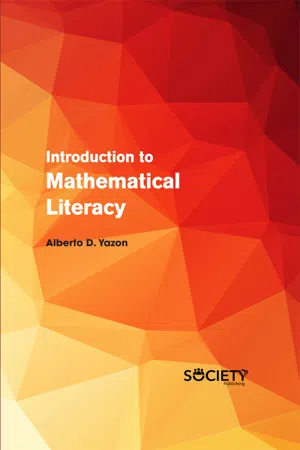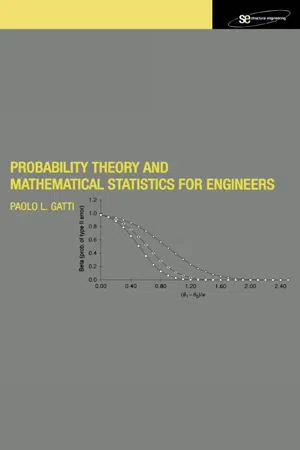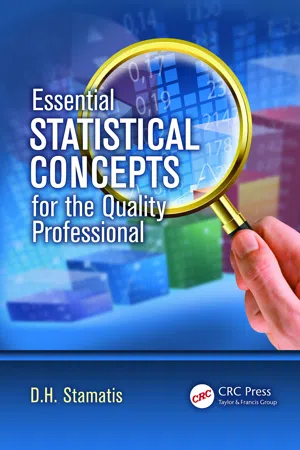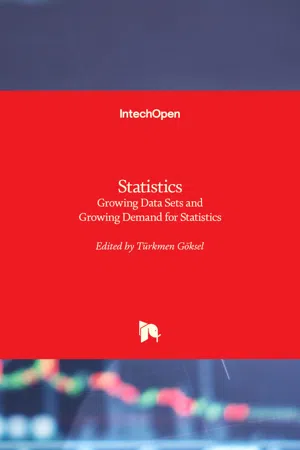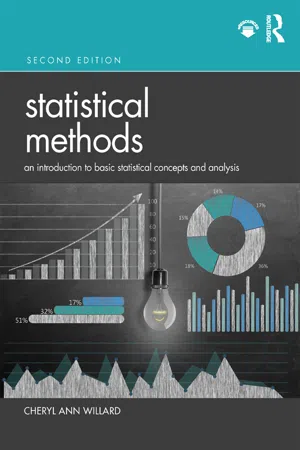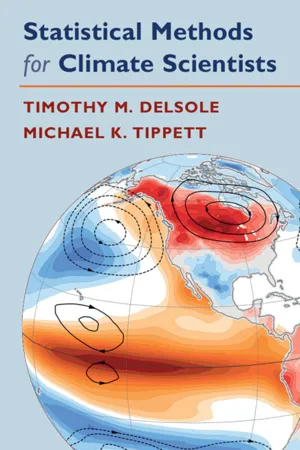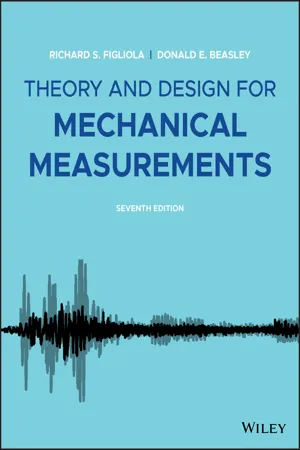Mathematics
Statistics
Statistics is a branch of mathematics that involves collecting, analyzing, interpreting, and presenting numerical data. It encompasses methods for summarizing and making inferences from data, as well as techniques for dealing with uncertainty and variability. Statistics is widely used in various fields such as science, business, economics, and social sciences to make informed decisions and draw meaningful conclusions from data.
Written by Perlego with AI-assistance
Related key terms
1 of 5
10 Key excerpts on "Statistics"
- eBook - PDF
- Alberto D. Yazon(Author)
- 2019(Publication Date)
- Society Publishing(Publisher)
Tools for statistical analysis and methods in Statistics such as descriptive methods, analytical methods, inductive methods, inferential methods, and applied methods have been mentioned in this chapter. This chapter provides further information about the func-tions of Statistics. 5.1. INTRODUCTION Statistics can be defined as the science of collecting, analyzing, presenting an interpreting data. In order to accelerate the theoretical as well as practical development in Statistics, it is required to turn the large amounts of data, which are available in a number of applied fields into useful information. Data are the facts and figures, which are collected, analyzed, and summarized for the purpose of presentation and interpretation. Data can be categorized into many types. Statistics is a very wide subject having applications in a large number of different fields. Generally, it can be said that the Statistics are the methodology used for collecting, analyzing, interpreting, and drawing conclusions from the information. Statistics can be said to be the methodology that is developed by scientists and mathematicians in order to interpret and draw results from the data which is collected (Figure 5.1). Figure 5.1: Statistics helps in data representation. Source: https://pixabay.com/illustrations/website-Statistics-business-3483020/. Even the small things which deal with the collection, processing, interpretation, and presentation of the data is included in the domain of Statistics: Organizing and Analyzing Data 107 Statistics. It also does the detailed planning of that introduces all these activities. Nowadays, its scope has been increased and more widened because of its pervading nature. Statistics is now usually used in almost all the fields of human knowledge and some skills such as commerce, business, social sciences, economics, politics, medicine, planning, and other sciences such as physical and natural. - Paolo L. Gatti(Author)
- 2004(Publication Date)
- CRC Press(Publisher)
Part II Mathematical Statistics 5 Statistics: preliminary ideas and basic notions 5.1 Introduction With little doubt, the theory of probability considered in the previous chap-ters is an elegant and consistent mathematical construction worthy of study in its own right. However, since it all started out from the need to obtain answers and/or make predictions on a number of practical problems, it is reasonable to expect that the abstract objects and propositions of the theory must either have their counterparts in the physical world or express relations between real-world entities. As far as our present knowledge goes, real-world phenomena are tested by observation and experiment and these activities, in turn, produce a set - or sets - of data. With the hope to understand the phenomena under investiga-tion - or at least of some of their main features - we 'manipulate' these data in order to extract the useful information. In experiments where elements of randomness play a part, the manipulation process is the realm of 'Statis-tics' which, therefore, is a discipline closely related to probability theory although, in solving specific problems, it uses techniques and methods of its own. Broadly speaking, the main purposes of Statistics are classified under three headings: description, analysis and prediction. In most cases, clearly, the distinction is not sharp and these classes are introduced mainly as a matter of convenience. The point is that, in general, the individual data are not important in themselves but they are considered as a means to an end: the measure of a certain physical property of interest, the test of a hypothesis or the prediction of future occurrences under given conditions. Whatever the final objectives of the experiment, statistical methods are techniques of 'inductive inference' in which a particular set (or sets) of data - the so-called 'realization of the sample' - is used to draw inferences of general nature on a 'population' under study.- D. H. Stamatis(Author)
- 2012(Publication Date)
- CRC Press(Publisher)
1 1 What Is Statistics? There is a tremendous confusion about Statistics and what it means. When one speaks about Statistics, the listener gets frustrated and the common response is, “It is all Greek to me.” Hopefully, this chapter explains what Statistics is and how it is used in improvement endeavors. The word Statistics has two different meanings. More commonly, Statistics means a collection of numerical facts or data, such as stock prices, profits of firms, annual incomes of college graduates, and so on. In its second meaning, it refers to an academic discipline, similar to physics, biology, and computer science. The field of Statistics can be divided into two parts: descriptive Statistics and inferential Statistics. Some years ago, the study of Statistics consisted mainly of the study of methods for summarizing and describing numeri-cal data. This study has become known as descriptive Statistics because it primarily describes the characteristics of large masses of data. (Formally, descriptive Statistics consists of procedures for tabulating or graphing the general characteristics of a set of data and describing some charac-teristics of this set, such as measures of central tendency or dispersion .) In many such statistical studies, data are presented in a convenient, easy-to-interpret form, usually as a table or graph. Such studies usually describe certain characteristics of the data, such as the center and the spread of the data. The methods used to collect statistical data often require knowledge of sampling theory and experimental design. Once the data have been col-lected, descriptive Statistics is used to summarize the raw data in a simple, meaningful way. Often, this is done by grouping the data into classes, thus forming what are called frequency distributions. When data are grouped into classes or categories, it becomes easy to see where most of the values are con-centrated, but some information or detail may be lost due to the grouping.- Aliakbar Montazer Haghighi, Indika Wickramasinghe(Authors)
- 2020(Publication Date)
- CRC Press(Publisher)
297 4 Descriptive Statistics 4.1 INTRODUCTION AND HISTORY OF Statistics It seems the word “Statistics” is based on “data” and “analysis of data”. In 1749, Statistik , a book in German, was published describing the analysis of demographic and economic data about the state (political arithmetic in English). However, the word “Statistics” originates from the Latin word “statisticum collegium”, which means “council of state”. “Statista” is the Italian word for Statistics that means “statesman” or “politician”. In 1800s, the word “Statistics” expanded its meaning to cover summarizing and analyzing data. It has further widened its scope to include the concept of probability for the purpose of statistical inference. 4.2 BASIC STATISTICAL CONCEPTS Statistics is essentially linked to the theory of probability, and probability theory is a branch of mathematics. Hence, it could be said that Statistics is a branch of mathematics. On the other hand, since Statistics deals with gathering, analyzing, and interpreting data, there are lots of human judgments involved in statistical analy-sis. This idea seems to separate Statistics from mathematics, to the extent that it is becoming difficult for pure mathematicians to accept Statistics as part of mathemat-ics. However, the second part of Statistics, inferential Statistics, is mainly mathemat-ics with less human judgment. Thus, Statistics is sometimes considered as a branch of mathematics, and at other times, a discipline in its own right. Regardless of how it is looked at, it is a very important concept now that its applications are so vast and diverse that no area of science can do without it. In fact, it has been so spread out that humanity, psychology, social sciences, and even communication cannot do without gathering and analysis of data. We start this chapter by defining some important terms that are widely used throughout this chapter.- eBook - PDF
Statistics
Growing Data Sets and Growing Demand for Statistics
- Türkmen Göksel(Author)
- 2018(Publication Date)
- IntechOpen(Publisher)
Section 1 The Role of Statistics on Quantification Chapter 1 Introductory Chapter: Statistics Türkmen Göksel Additional information is available at the end of the chapter http://dx.doi.org/10.5772/intechopen.79773 1. Introduction “Statistics is the grammar of Science,” a famous quote by Karl Pearson who was the British statistician and leading founder of the modern field of Statistics. Pearson highlights the impor -tance of Statistics and particularly emphasizes the significance of quantification for various fields of scientific study in his publication, The Grammar of Science [ 1 ]. Statistics is defined as the study of the collection, analysis, interpretation, presentation, and organization of data by the Oxford Dictionary of Statistical Terms [ 2 ]. Since the data grow faster than ever and information is increasing tremendously nowadays, the role of Statistics becomes more crucial. In general, we can group statistical analysis into two parts: (i) descriptive Statistics and (ii) inferential (analytical) Statistics. Descriptive Statistics is used to summarize and/or describe a collection of data. Therefore, descriptive Statistics provides a powerful way to summarize what already exists in data. However, inferential Statistics focuses on the patterns in the data and then draws inferences from these patterns. In other words, by analyzing data gathered from samples (smaller subsets of the entire population), statistical methods infer about populations. The field of Statistics is the science of learning from data. In other words, Statistics is the tool we use to convert data into information. Decisions based on data and information will provide better outcomes than those just based on intuition or gut feelings. In our daily life, there is almost no human activity where the application of Statistics is not needed. - eBook - PDF
- Michael P. Marder(Author)
- 2011(Publication Date)
- Cambridge University Press(Publisher)
3 Statistics 3.1 Motivations for Statistics Statistics is the mathematics of measurement and data. The data might come from measuring the height of a friend, the sizes of fish in a lake, flipping coins, the rate electrons are ejected from a metal illuminated by light, or mathematics test scores of students in Iowa. The tools of Statistics are needed whenever the data are partly predictable and partly influenced by factors too complex fully to understand. Statis-tics makes it possible to summarize the meaning of huge numbers of measurements in a compact form, and to explain the significance of the measurements even when chance makes them uncertain. Two of the main reasons to learn Statistics are to deal with measurement error and to be able to describe distributed quantities. Measurement error Chapter 2 discussed the fact that almost any attempt to measure values obtains numbers that vary from one trial to the next. It provided recipes for dealing with the variation but no explanation for why the recipes work. This chapter returns to the problem and explains the solutions in more detail. Suppose you are trying to measure the height of your friend Anne with a ruler. You make the measurement a first time and find she is 1.721 m tall. When you repeat the measurement, the meter stick tilts at a slight angle, and you get 1.722 m. You try again, and she slouches slightly, so you get 1.718 m. No matter how often you make the measurement, you continue to get slightly different numbers. The general name for errors of this sort is measurement error . These errors are inevitable and maybe a bit annoying. Anne, you think, has a height, and you would like to find it. Statistics will tell you how to assemble the many measurements into one number. Nothing will tell you Anne’s true height, for if repeated measure-ments do not agree completely, the true height comes to depend upon definition as much as measurement. Yet Statistics teaches that it is not pointless to make 51 - eBook - PDF
Statistical Methods
An Introduction to Basic Statistical Concepts and Analysis
- Cheryl Ann Willard(Author)
- 2020(Publication Date)
- Routledge(Publisher)
However, researchers should note any limitations of their sample that should be taken into consideration in generalizing results to the population at large. Statistical procedures can be broken down into two different types. Descriptive Statistics sum up and condense a set of raw scores so that overall trends in the data become apparent. Percentages and averages are examples of descriptive Statistics. Inferential Statistics involve predicting characteristics of a population based on data obtained from a sample. A defini-tion of Statistics in general was previously given as the procedures used for organizing and analyzing information. More narrowly, a statistic is a numerical value that originates from a sample, whereas a parameter is a numerical value that represents an entire population. Parameters are usually inferred from samples rather than being calculated directly. However, it cannot be assumed that the values predicted by a sample will reflect the population values exactly. If we drew another sample from the same population, we would likely get a some-what different value. Even though we may be using a representative sample, we still do not have all the information that we would have if we were measuring the population itself. Thus, a certain amount of error is to be expected. The amount of error between a sample statistic and a population parameter is referred to as sampling error . Inferential Statistics are used to assess the amount of error expected by chance due to the randomness of the samples. INTRODUCTION TO Statistics • 5 MEASUREMENT Statistics involves the measurement of variables. A variable is anything that varies or that can be present in more than one form or amount. Variables describe differences. These can be differences in individuals, such as height, race, or political beliefs. Variables are also used to describe differences in environmental or experimental conditions, such as room tempera-ture, amount of sleep, or different drug dosages. - eBook - PDF
- Mike Allen, Scott Titsworth, Stephen K. Hunt(Authors)
- 2008(Publication Date)
- SAGE Publications, Inc(Publisher)
In fact, Chapter 1 started your new language training by introducing the notion of “design.” You learned, for instance, that there are different ways to sequence observations and manipulations to achieve research designs with varying levels of sophistication. In this chapter, we begin with a “nuts-and- bolts” discussion of various types of Statistics—many of which you may already be familiar with. Second, we discuss how Statistics are used to engage in hypothesis testing. We conclude with a discussion of how statistical short- hand (i.e., various symbols and other notations) are used when writing the results of statistical analyses. TYPES OF Statistics Any initial understanding of Statistics should be grounded in an understand- ing of how we can use numbers to describe a sample. Typically, descriptive Statistics help us understand how to describe the frequency of values, the central tendency of values, and/or the dispersion of values. Using these basic descriptors, you can move on to calculate more advanced Statistics and diag- nose potential problems with your data set. This section reviews those basic Statistics. Frequency Distributions When you have a range of values, it is often valuable to determine how frequently each value is represented. For example, if you selected a sample of college students, you might want to know the frequency with which men and women were randomly selected or the frequency with which freshmen, sophomores, juniors, or seniors are represented. By calculating a frequency distribution, you can determine just that—the number of people within each category as well as the percentage of the whole represented by that number. So, for instance, you might observe that out of a random sample of 100 college students, there are 42 men (42%) and 58 women (58%). Although frequency distributions are commonly used to analyze cat- egorical variables (e.g., the sex or year in school examples), they can also be used to analyze continuous variables. - eBook - PDF
- Timothy DelSole, Michael Tippett(Authors)
- 2022(Publication Date)
- Cambridge University Press(Publisher)
1 Basic Concepts in Probability and Statistics Probability theory is nothing more than common sense reduced to calculation. Pierre Simon Laplace This chapter reviews some essential concepts of probability and Statistics, including the following: • line plots, histograms, scatter plots • mean, median, quantiles, variance • random variables • probability density function • expectation of a random variable • covariance and correlation • independence • the normal distribution (also known as the Gaussian distribution) • the chi-squared distribution. These concepts provide the foundation for the statistical methods discussed in the rest of this book. 1 2 Basic Concepts in Probability and Statistics 1990 1992 1994 1996 1998 2000 25 27 29 year Nino 3.4 index (°C) Nino 3.4 index (raw) Figure 1.1 A time series of the monthly Niño 3.4 index over the period 1990–2000. 1.1 Graphical Description of Data Scientific knowledge is based on observations. However, a mere list of observational facts rarely advances science. Instead, the data need to be organized in ways that help the scientist interpret the data in a scientific interpret the data in a scientific framework and formulate new hypotheses that can be checked in independent data or experiments. To illustrate ways of describing the main characteristics of a data set, consider a specific observable quantity: the area-average sea surface temperature in the equatorial Pacific in the region 170 ◦ W − 120 ◦ W and 5 ◦ S − 5 ◦ N. This quantity is called the Niño 3.4 index and is an indicator of seasonal climate variations. The monthly average value of this index over a period of 50 or more years is readily avail- able from various data portals. What are some ways of describing such a data set? Data taken sequentially in time are known as time series. A natural way to visual- ize time series is to plot them as a function of time. A time series plot of Niño 3.4 is shown in Figure 1.1. - Richard S. Figliola, Donald E. Beasley(Authors)
- 2019(Publication Date)
- Wiley(Publisher)
The value of (1) can vary with repeated data sets, so the difference between it and the true average value of the population is a type of random error. Additionally, (3) requires establishing an interval within which the true average value of the population is expected to lie. This interval quantifies the probable range of this random error and is called a random uncertainty. This chapter presents an introduction to the concepts of probability and Statistics at a level sufficient to provide information for a large class of engineering judgments. Such material allows for the reduction of raw data into results. We use terminology common to engineering, and it is not meant to replace a sound study of inferential Statistics. Upon completion of this chapter, the reader will be able to: • Quantify the statistical characteristics of a data set as it relates to the population of the measured variable • Explain and use probability density functions to describe the behavior of variables • Quantify a confidence interval about the measured mean value at a given probability and to apply hypothesis tests about the behavior of engineering measurements • Perform regression analysis on a data set and quantify the confidence intervals for the param- eters of the resulting curve fit or response surface • Execute a Monte Carlo simulation that predicts the behavior expected in a result due to varia- tions in the variables involved in computing that result 97 98 PROBABILITY AND Statistics 4.2 Statistical Measurement Theory Sampling refers to obtaining a set of data through repeated measurements of a variable under fixed operating conditions. This variable is known as the measured variable or, in statistical language, the measurand. We take the sampling from the population of all possible values of the measured variable.
Index pages curate the most relevant extracts from our library of academic textbooks. They’ve been created using an in-house natural language model (NLM), each adding context and meaning to key research topics.
